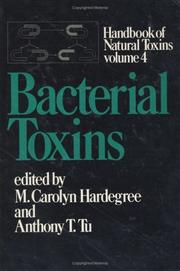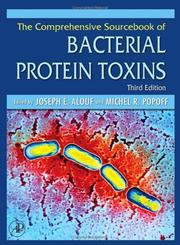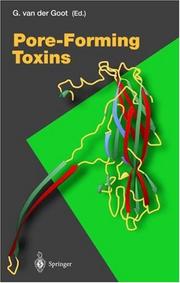| Listing 1 - 10 of 103 | << page >> |
Sort by
|

ISBN: 9780824778408 0824778405 Year: 1988 Publisher: New York: Dekker,
Abstract | Keywords | Export | Availability | Bookmark
 Loading...
Loading...Choose an application
- Reference Manager
- EndNote
- RefWorks (Direct export to RefWorks)
Book
ISBN: 0442307640 Year: 1983 Publisher: Wokingham : Van Nostrand Reinhold,
Abstract | Keywords | Export | Availability | Bookmark
 Loading...
Loading...Choose an application
- Reference Manager
- EndNote
- RefWorks (Direct export to RefWorks)
Multi
ISBN: 9780128005897 0128005890 0128001887 9780128001882 Year: 2015 Publisher: Amsterdam, Netherlands : Elsevier,
Abstract | Keywords | Export | Availability | Bookmark
 Loading...
Loading...Choose an application
- Reference Manager
- EndNote
- RefWorks (Direct export to RefWorks)
The Comprehensive Sourcebook of Bacterial Protein Toxins 4th Edition, contains chapters written by internationally known and well-respected specialists. This book contains chapters devoted to individual toxins, as well as chapters that consider the different applications of these toxins. Considerable progress has been made in understanding the structure, function, interaction and trafficking into cells, as well as mechanism of action of toxins. Bacterial toxins are involved in the pathogenesis of many bacteria, some of which are responsible for severe diseases in human and animals, but can al

ISBN: 9780120884452 0120884453 0080456987 9780080456980 1280628464 9786610628469 Year: 2006 Publisher: Amsterdam ; Boston : Elsevier,
Abstract | Keywords | Export | Availability | Bookmark
 Loading...
Loading...Choose an application
- Reference Manager
- EndNote
- RefWorks (Direct export to RefWorks)
This book describes the major achievements and discoveries relevant to bacterial protein toxins since the turn of the new century illustrated by the discovery of more than fifty novel toxins (many of them identified through genome screening). The establishment of the three-dimensional crystal structure of more than 20 toxins during the same period offers deeper knowledge of structure-activity relationships and provides a framework to understand how toxins recognize receptors, penetrate membranes and interact with and modify intracellular substrates.* Edited by two of the most highly re
Book
Year: 2018 Publisher: Basel, Switzerland : MDPI - Multidisciplinary Digital Publishing Institute,
Abstract | Keywords | Export | Availability | Bookmark
 Loading...
Loading...Choose an application
- Reference Manager
- EndNote
- RefWorks (Direct export to RefWorks)
Increased awareness about environmental adverse effects of human activities has prompted the use of insecticides with low impact on systems associated to agriculture. Currently, the most successful biological products are based on protein toxins from the bacterial species Bacillus thuringiensis. Because of the remarkable properties of these proteins, their encoding genes were introduced into farming species (the so called Bt-crops), in such a way, that these plants are self-protected against some key insect pests. Despite the fact that a relatively large number of these toxins, with different toxicity ranges, have been described, it is still important to find new resources with novel capabilities to complement, or to replace in the future, the currently used ones. On another hand, it is important to continue studying their mode action in susceptible insects, and the changes occurred in resistant ones, to determine the most effective strategy for long lasting pest control. The focus of this Special Issue of Toxins is to provide updated information on the use of B. thuringiensis and their toxins on different field crops, the interactions of these toxins with other molecules, analyze the biochemical and molecular basis of emerging cases of resistance and, in general, to provide information which can contribute to an effective pest management with these toxins.
Book
Year: 2018 Publisher: Basel : MDPI AG - Multidisciplinary Digital Publishing Institute,
Abstract | Keywords | Export | Availability | Bookmark
 Loading...
Loading...Choose an application
- Reference Manager
- EndNote
- RefWorks (Direct export to RefWorks)
Annotation Bridging cellular membranes is a key step in the pathogenic action of both binary and pore-forming bacterial toxins. The former use their translocation domains, containing various structural motifs, to ensure efficient delivery of the toxic component into the host cell, while the latter act on the cellular membrane itself. In either case, the integrity of the membrane is compromised via targeted protein-lipid and protein-protein interactions triggered by specific signals, such as proteolytic cleavage or endosomal acidification. This Special Issue presents recent advances in characterizing functional, structural and thermodynamic aspects of the conformational switching and membrane interactions involved in the cellular entry of bacterial protein toxins. Deciphering the physicochemical principles underlying these processes is also a prerequisite for the use of protein engineering to develop toxin-based molecular vehicles capable of targeted delivery of therapeutic agents to tumors and other diseased tissues.
Book
Year: 2018 Publisher: Basel, Switzerland : MDPI - Multidisciplinary Digital Publishing Institute,
Abstract | Keywords | Export | Availability | Bookmark
 Loading...
Loading...Choose an application
- Reference Manager
- EndNote
- RefWorks (Direct export to RefWorks)
Increased awareness about environmental adverse effects of human activities has prompted the use of insecticides with low impact on systems associated to agriculture. Currently, the most successful biological products are based on protein toxins from the bacterial species Bacillus thuringiensis. Because of the remarkable properties of these proteins, their encoding genes were introduced into farming species (the so called Bt-crops), in such a way, that these plants are self-protected against some key insect pests. Despite the fact that a relatively large number of these toxins, with different toxicity ranges, have been described, it is still important to find new resources with novel capabilities to complement, or to replace in the future, the currently used ones. On another hand, it is important to continue studying their mode action in susceptible insects, and the changes occurred in resistant ones, to determine the most effective strategy for long lasting pest control. The focus of this Special Issue of Toxins is to provide updated information on the use of B. thuringiensis and their toxins on different field crops, the interactions of these toxins with other molecules, analyze the biochemical and molecular basis of emerging cases of resistance and, in general, to provide information which can contribute to an effective pest management with these toxins.
Book
ISBN: 3437114212 Year: 1992 Publisher: Stuttgart Fischer
Abstract | Keywords | Export | Availability | Bookmark
 Loading...
Loading...Choose an application
- Reference Manager
- EndNote
- RefWorks (Direct export to RefWorks)
Book
Year: 2018 Publisher: Basel : MDPI AG - Multidisciplinary Digital Publishing Institute,
Abstract | Keywords | Export | Availability | Bookmark
 Loading...
Loading...Choose an application
- Reference Manager
- EndNote
- RefWorks (Direct export to RefWorks)
Annotation Bridging cellular membranes is a key step in the pathogenic action of both binary and pore-forming bacterial toxins. The former use their translocation domains, containing various structural motifs, to ensure efficient delivery of the toxic component into the host cell, while the latter act on the cellular membrane itself. In either case, the integrity of the membrane is compromised via targeted protein-lipid and protein-protein interactions triggered by specific signals, such as proteolytic cleavage or endosomal acidification. This Special Issue presents recent advances in characterizing functional, structural and thermodynamic aspects of the conformational switching and membrane interactions involved in the cellular entry of bacterial protein toxins. Deciphering the physicochemical principles underlying these processes is also a prerequisite for the use of protein engineering to develop toxin-based molecular vehicles capable of targeted delivery of therapeutic agents to tumors and other diseased tissues.

ISBN: 3540413863 Year: 2001 Publisher: Berlin Springer
Abstract | Keywords | Export | Availability | Bookmark
 Loading...
Loading...Choose an application
- Reference Manager
- EndNote
- RefWorks (Direct export to RefWorks)
| Listing 1 - 10 of 103 | << page >> |
Sort by
|

 Search
Search Feedback
Feedback About UniCat
About UniCat  Help
Help News
News